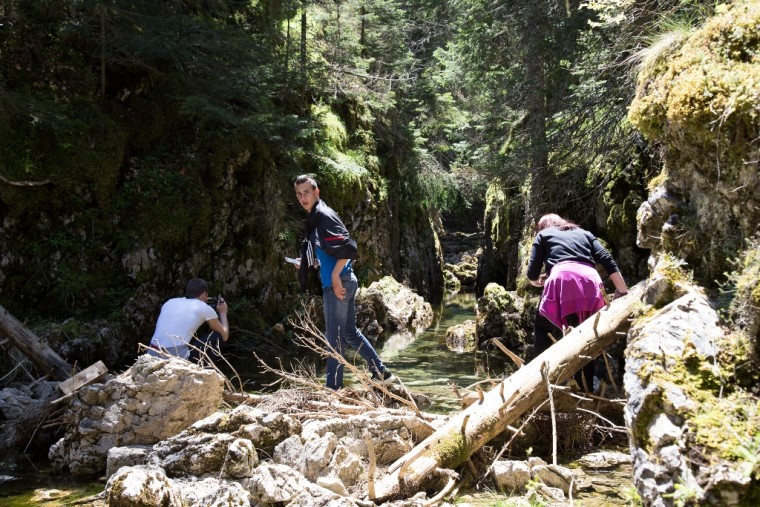The project activity “Tour natural heritage sites and collecting materials” in Žabljak was realized in the period from 09.06. to 12.06. 2016, which is the last tour of sites of natural heritage in the framework of the project “Working Together for Inclusive European Future”.
15 students from Foča and 15 students from Žabljak, accompanied by teachers, guide and biologist visited the area “Prsten oko Durmitora”, and they found out why Durmitor represents the magnificent natural value and lasting inspiration for scientists and nature lovers, they also learned a lot about the richness of flora and fauna, ecosystem, presence of a large number of endemic and relict species.
“Prsten oko Durmitora”, connects Žabljak (1450m) over “ Štuoc” (1950m) – also the highest point of the route, the river canyon “Sušica”, the village “Nedajno “, Piva mountain and plateau, the village “Trsa”, glacial lakes “Valovit”, “Modro” and “Pošćensko”, the mountain peaks ”Prutaš” and “Sedlo”, lake plateau and ski center “Savin kuk”
The participants of this activity were particularly interested in the canyon of the river “Sušica “,that is one of the most beautiful and most impressive canyons in Montenegro, but also on the entire Balkan Peninsula, of course, after the canyon river Tara. “Susica “canyon is listed in the I zone of protection, because the value of ecosystems and the special value of the flora and vegetation. This reservation includes the area of 2360 hectares (“Škrk “lake, “Skakala”, “Sušica” lake, the canyon “Sušica” to the Tara river).
The Canyon is the boundary between Durmitor and Piva mountains. It is narrow and wild cracks, its sides are covered with coniferous and mixed forests. The yew grows here, the only conifer that can successfully rejuvenate from the stump (there is the traditional beliefs that it is sacred tree, perfect for making a talisman).
The river “Sušica” is 14 kilometers long and the greater part of its flow is the underground river. Overall drop in river is about 800 meters (it springs at 1300m and flows into the river Tara at 512m). At the distance of three-four kilometers of its spring, it forms “Susica” lake. The lake exists only from early spring to late June, the biggest depth of the lake is 4.5m. An indescribable experience is watching the lake from bird’s eye perspective exactly from the cliffs of the canyon.
At high altitudes, where sharp mountain climate does not allow the survival even the most resistant trees, the alpine vegetation of mountain meadows grows there. There are many the arctic-alpine representatives of flora. High mountain areas and cliffs are the centers of preserving ancient tertiary and glacial flora, characterized by the abundance of endemic species and genera. According to current data, of the 1,325 flora species of Durmitor and the surrounding canyons, 122 are high-mountain endemic, which is 77% of the total endemic flora of that area.
The canyon “Sušica” – containing well-preserved beech and fir forests with impressive specimens of trees and stands of beech and maple, white ash and mountain elm. A small group of maple trees is very important and represents a true natural archive of this kind, and needs to be nurtured as source of genetic material. The large number of maple trees is exceptional high. The canyon is the habitat of numerous relict species.
In the forests of the canyon can be found: the brown bear, wolf, wild boar, wild cat, chamois, different species of eagles, black cock and partridge. Balkan Chamois stands by its beauty. In the summer it lives above the upper limit of the forest, and in the winter it descends lower among pine shrubs and in the upper parts of the forest.
On the list of rare, endemic and endangered species of mammals in Durmitor area are: all kinds of bats, mole rat and otter.
Among the numerous Balkan and Dinaric endemics, it is significant presence of local Montenegrin endemic species (mountain maple, “Glisic zvončac”, mullein, valerian, Nikolayev’s violet, “Dafnijev i Malijev Jeremicak”, iris…)
The peculiarity of extremely rich flora of the National Park makes about 400 species of remedies. More than 40 species of wild edible mushrooms grow there, and it is considered a special reservation in Europe. 168 species of birds, including rarities are black grouse, golden eagle, partridge, flacon, griffon vulture and many other live there.
There is also a large number of relict and endemic species among insects. In the summer, as nowhere else, you can see lots of different species of butterflies and beetles on the meadows (about 130 butterfly species), and among them there is the APOLLO, because of its beauty it is the most frequent target of collectors, and it is on the list of the protected species.
In addition to Durmitor and Tara canyon have been on the UNESCO list of protected areas for decades, they are also identified as areas of IPA (Important Plant Area) – important for the conservation of rare, endemic and endangered plant species. Thus, these species and their habitats provide an international significance in the preservation of the gene pool and the total plant diversity.
30 students (15 from Foča and 15 from Žabljak) together with their professors took part in this project activity.
A lot of photos and videos were taken and recorded, which were being processing by the students later in the school premises.



 BiH
BiH MNE
MNE